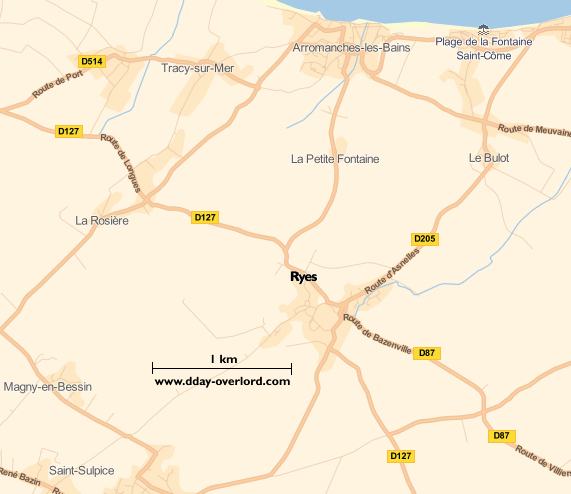Ryes (Calvados)
The cities of Normandy during the 1944 battles
- Liberation: June 6, 1944
- Deployed units:
![]() 1st Battalion Dorsetshire Regiment, 231st Infantry Brigade, 50th Infantry Division
1st Battalion Dorsetshire Regiment, 231st Infantry Brigade, 50th Infantry Division
![]() 2nd Battalion Devonshire Regiment, 231st Infantry Brigade, 50th Infantry Division
2nd Battalion Devonshire Regiment, 231st Infantry Brigade, 50th Infantry Division
![]() Royal Engineers 25th Airfield Construction Group
Royal Engineers 25th Airfield Construction Group
![]() 1/Grenadier-Regiment 916, 352. Infanterie-Division
1/Grenadier-Regiment 916, 352. Infanterie-Division
- History:
After its landing on Gold Beach at 8.15 am, the 2nd Battalion Devonshire Regiment “Devon” belonging to the 231st brigade of the 50th British infantry division progressed towards the commune of Ryes (however, one of its companies ‘Is reinforced by the 1st Battalion Hampshire Regiment, which is fixed at the Hamel in front of the German Wn 37 strongpoint). The “Devon” is supported by the 1st Battalion Dorsetshire Regiment.
The Devonshire Regiment seized Ryes at about 5.30 pm without encountering any major opposition and settled in the area, setting up a cover directed towards Le Hamel where the fighting continued until mid-afternoon. The Dorsetshire Regiment then picked up “Devon” in position so that it could continue its action towards Longues-sur-Mer.
From 30 June to 5 July 1944, the Royal Engineers 25th Airfield Construction Group constructed a compacted earth track called ALG B-15, which was used for the evacuation of the wounded and for the refueling and ammunition of the various squadrons distributed in the Calvados. A field hospital is located on the southern edge of the trail near the so-called Longchamps site.
Ryes Military Cemetery contains 979 graves, including 630 British, 326 Germans, 21 Canadians, one Australian and one Polish.
Ryes maps:

